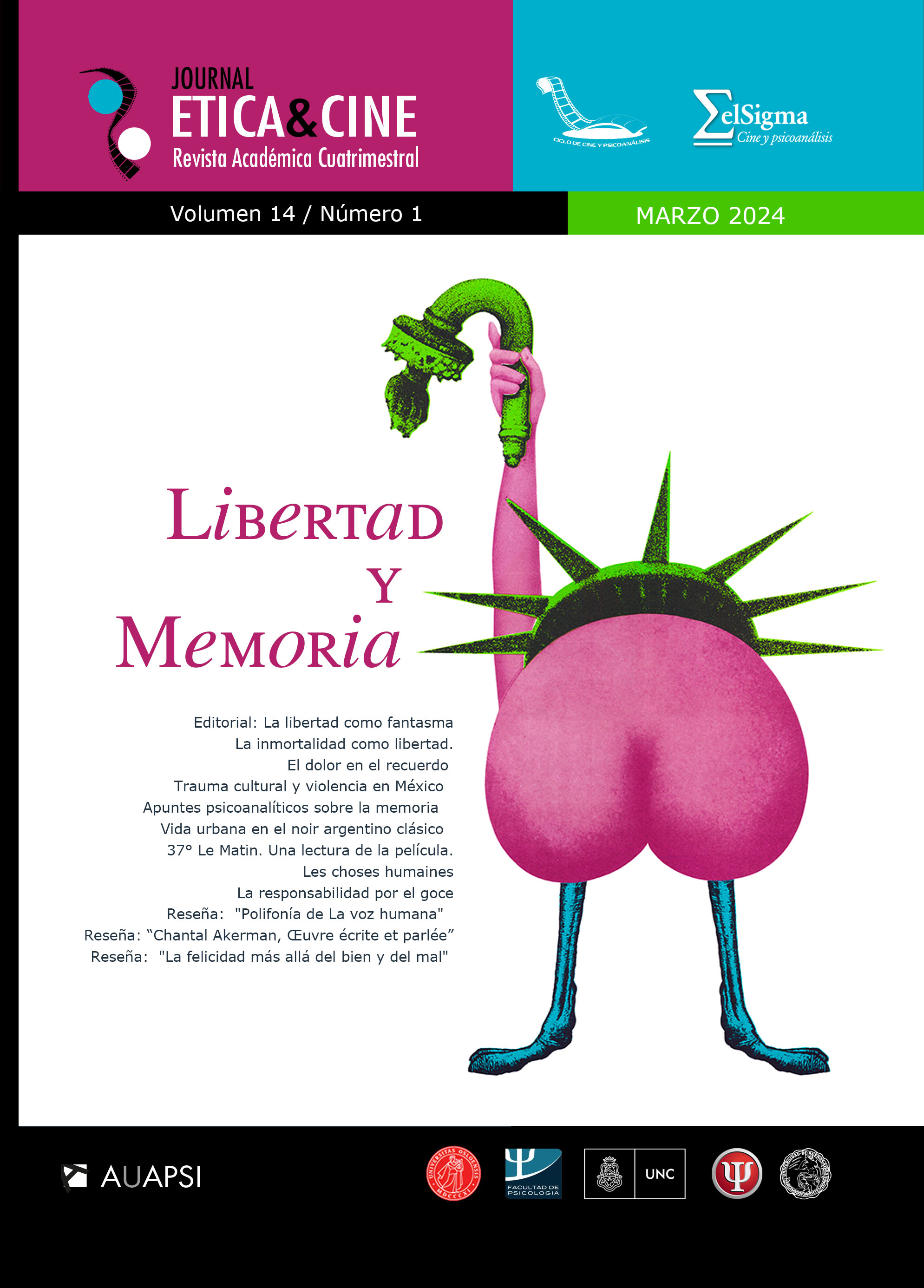The city of excited nerves: urban life in classic Argentine film noir
DOI:
https://doi.org/10.31056/2250.5415.v14.n1.44634Keywords:
film noir, Argentina, peronism, city, affectionsAbstract
In the following article we propose to carry out the analysis of the films Apenas un delincuente (Fregonese, 1949), Del otro lado del puente (Rinaldi, 1953) and Final Rehearsal (Lugones, 1955), works belonging to the Argentine film noir made during Peronism, in which urban life takes center stage. Starting from the study of the affective mappings of the protagonists, we will try to demonstrate how a Peronist feeling develops in its paths, while we will develop a study of the spaces in the Argentine variant of the noir genre.
Downloads
References
Acha, O. (2014). Crónica sentimental de la Argentina peronista: sexo, inconsciente e ideología, 1945-1955. Prometeo Libros.
Ballent, A. (2009). Las huellas de la política: Vivienda, ciudad, peronismo en Buenos Aires, 1943-1955. Universidad Nacional de Quilmes, Prometeo 3010.
Berardi, M. (2006) La vida imaginada. Vida cotidiana y cine argentino 1933-1970. Ediciones del Jilguero.
Bernini, E. (2016). Políticas del policial en el cine argentino. En Setton, R. y Pignatello, G. (comps.) Crimen y pesquisa. El género policial en la Argentina (1870-2015): literatura, cine, televisión, historieta y testimonio (pp. 185-192). Título.
Blanco Pazos, R. y Clemente, R. (2004). De La Fuga a La Fuga: El policial en el cine argentino. Corregidor.
Borde, R. y Chaumeton, E. (1958). Panorama del cine negro. Losange.
Bruno, G. (2017). Una Geografía de la Imagen en Movimiento. laFuga, (20), s/n. https://www.lafuga.cl/una-geografia-de-la-imagen-en-movimiento/850
Cecchi, A. V. (2009). Polifónicas imágenes delictivas: narrar a Ruggierito. En Actas de las Segundas Jornadas Nacionales de Historia Social. Centro de Estudios Históricos “Prof. Carlos S.A. Segreti”.
De Certeau, M. (2007). La invención de lo cotidiano. 1. Artes de hacer. Universidad Iberoamericana. Instituto Tecnológico y de Estudios Superiores de Occidente.
Esquenazi, J.P. (2018). El film noir: historia y significaciones de un género popular subversivo. El cuenco de plata.
Flatley, J. (2008). Affective Mapping. Melancholia and the Politics of Modernism. Harvard University Press.
Grob, N. (2008). Einleitung. Kino der Verdammnis. En Norbert Grob (Ed.) Filmgenres. Film noir (pp. 9-23) Philip Reclam jun.
Kratje, J. (2018). Atmósferas generizadas. Sobre algunas apropiaciones teóricas de las nociones de Stimmung e idiorritmia para el estudio del cine. Caiana (12), 26-39. http://hdl.handle.net/11336/176044
Kriger, C. (2006). La presencia del estado en el cine del primer peronismo [Tesis presentada con el fin de cumplimentar con los requisitos finales para la obtención del título en Doctor en Artes.] Facultad de Filosofía y Letras, Universidad de Buenos Aires.
Massey, D. (2005) For Space. SAGE Publications.
Naremore, J. (2008) More Than Night: Film Noir in its Contexts. University of California Press.
Romero, J. L. (2001). Latinoamérica: las ciudades y las ideas. Siglo Veintiuno.
Sobchack, V. (1992). The Address of the Eye: A Phenomenology of Film Experience. Princeton. Princeton University Press.
Sobchack, V. (1998). Lounge Time: Postwar Crises and the Chronotype of Film Noir. En N. Browne (Ed.) Refiguring American film genres: history and theory (pp. 129-170). Berkeley. University of California Press.
Williams, L. (1991). Film Bodies: Gender, Genre, and Excess. Film Quarterly, 44(4), 2-13. https://doi.org/10.2307/1212758
Downloads
Published
How to Cite
Issue
Section
License
Copyright (c) 2024 Ética y Cine Journal

This work is licensed under a Creative Commons Attribution-ShareAlike 4.0 International License.
Los autores que publiquen en Ética y Cine Journal aceptan las siguientes condiciones:
Los autores/as conservan los derechos de autor © y permiten la publicación a Ética y Cine Journal, bajo licencia CC BY-SA / Reconocimiento - Reconocimiento-CompartirIgual 4.0 Internacional. La adopción de esta licencia permite copiar, redistribuir, comunicar públicamente la obra, reconociendo los créditos de la misma, y construir sobre el material publicado, debiendo otorgar el crédito apropiado a través de un enlace a la licencia e indicando si se realizaron cambios.

Este obra está bajo una licencia de Creative Commons Reconocimiento-CompartirIgual 4.0 Internacional.




